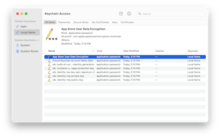Keychain (Mac OS)
| Developer(s) | Apple Inc. |
|---|---|
| Operating system | Mac OS 9, macOS |
| Type | system utility |
| License | APSL |
| Website | Keychain programmers guide |

Screenshot of Keychain Access on Mac OS X 10.5.
|
|
| Developer(s) | Apple Inc. |
|---|---|
| Stable release |
9.0 (55161) / October 16, 2014
|
| Operating system | Mac OS 9, macOS |
| Type | password manager |
| Website | http://www.apple.com |
Keychain is password management system in macOS developed by Apple. It was introduced with Mac OS 8.6, and has been included in all subsequent versions of Mac OS, including macOS. A Keychain can contain various types of data: passwords (for websites, , SSH accounts, network shares, wireless networks, groupware applications, encrypted disk images), private keys, certificates, and secure notes.
In macOS, keychain files are stored in ~/Library/Keychains/, /Library/Keychains/, and /Network/Library/Keychains/, and the Keychain Access GUI application is located in the Utilities folder in the Applications folder. It is free, open source software released under the terms of the APSL. The command line equivalent of Keychain Access is /usr/bin/security.
The keychain file(s) stores a variety of data fields including a title, URL, notes and password. Only the passwords and Secure Notes are encrypted, with Triple DES.
The default keychain file is the login keychain, typically unlocked on login by the user's login password, although the password for this keychain can instead be different from a user’s login password, adding security at the expense of some convenience. The Keychain Access application does not permit setting an empty password on a keychain.
The keychain may be set to be automatically "locked" if the computer has been idle for a time, and can be locked manually from the Keychain Access application. When locked, the password has to be re-entered next time the keychain is accessed, to unlock it. Overwriting the file in ~/Library/Keychains/ with a new one (e.g. as part of a restore operation) also causes the keychain to lock and a password is required at next access.
...
Wikipedia
